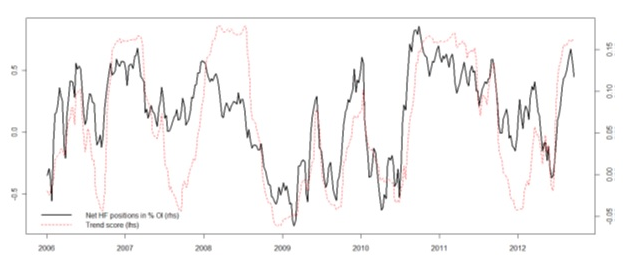Benoit Guilleminot and two colleagues have written a working paper on the impact of index flows on commodities prices, using U.S. traded (agricultural) commodities as their database. Along the way, they encourage thought about the nature of cause and effect in finance.
There are many uses of terms such as “cause.” Sometimes, we use the word to refer to something that is happening at the same time as its effect. As the wind moves through the trees the leaves rustle. As the water rises and falls in the ocean in a wave pattern, a surfer slides toward shore.
At other times though, we use “cause” to refer to an event that clearly preceded its effect in time. One pool ball hit another and stopped: the second ball then moved forward. Penetration by a bullet caused the victim’s death.
It is this second more time-specific sense of causation that has encouraged the notion of “Granger causality.”
Derivatives and their Underlyings
In May 2008, Michael Masters , a portfolio manager himself, testified before the Homeland Security Committee of the U.S. Senate and maintained that a new class of institutional investors had skewed commodities futures markets, causing a rise in the prices not only of the derivatives, but on the underlyings. He called the new class of investors the “index speculators,” because their strategy is to allocate across the 25 key commodities futures covered by most popular indices.
There certainly was a run-up in commodity index flows and prices during the two year period preceding Masters’ testimony. But a number of authors have produced other explanations of those twin run-ups. Perhaps the most obvious alternative explanation is that the rise in prices invited the speculators to move into the indexes, and that Masters simply had reversed the causal arrow.
One of the important items of economics’ jargon here is “Granger causality.” One fact “Granger causes” another if it reliably precedes that other. Granger causality isn’t the same thing as real causality. A virus may infect a human body and cause a variety of symptoms in a certain dependable sequence. The early symptoms then reliably forecast the later symptoms. This doesn’t mean that the early symptoms cause the latter symptoms, that the cough causes the rash. Nonetheless, we would say that the cough “Granger causes” the rash.
Granger causality can be an important though non-decisive clue to full-throated, before-therefore-after causality. If a rise in a certain type of speculative flow preceded the rise in commodity prices, it would support the hypothesis that the one caused the other.
A Misleading Clue
Guilleminot and his colleagues, Jean-Jacques Ohana and Steve Ohana, think that on this issue Granger causality has been a misleading test. They acknowledge that most studies fail to show any Granger causality, any forecasting of price changes by index-oriented flow.
But they also contend that the relationship of index flows and commodity prices is not a before-and-after sort of causation. It is a contemporaneous relation. Think of it as akin to the relationship between a wind passing through the trees and the rustling of the leaves. Both events occur at the same time, so neither predicts the other. Neither can be said the “Granger” cause the other. Yet common sense tells us that the wind causes the rustling of the trees, not the other way around.
Source: Guilleminot et al., The Interaction of Hedge Funds and Index Investors in Agricultural Derivatives Markets
For twelve agricultural commodities traded in the U.S., the CFTC releases trading breakdowns on a week by week basis in terms of three well-defined categories: commodity index traders (or CIT); commercial non-CIT; and non-commercial non-CIT.
The non-commercial non-CIT component are those Guilleminot and et al call, for short, hedge funds. The commercial non-CIT is the Main-Street hedger: “buyers, processors, physical traders and producers that mostly use derivatives markets for the purpose of hedging commodity price risk.” The first group, the CIT traders, are those whose weight in the market worried Masters.
Trend Following
The twelve categories are listed along the X axis of the above graph, presented in order from the commodity with the largest average open interest in thousands of lots (corn), to the one with the smallest average open interest (feeder cattle.)
Source: Guilleminot et al., The Interaction of Hedge Funds and Index Investors in Agricultural Derivatives Markets
Another graph in their paper, also shown here, displays the moving positions of hedge funds in the corn market, as the black line. The red line results from a “smooth momentum indicator” these authors have created to characterize the average net positioning of trend following systems.
The two track each other to a marked although of course an imperfect extent. It is so marked a correlation, that the authors conclude that “the trend following strategy is indeed very representative of the aggregate positioning of hedge funds in agricultural derivatives markets.”
That leaves a very real possibility that there is a contemporaneous cause and effect relationship, that the entry of a lot of index investors causes to the entry of trend-following hedge funds, and together they have caused a significant increase in the price of corn.
- English (UK)
- English (India)
- English (Canada)
- English (Australia)
- English (South Africa)
- English (Philippines)
- English (Nigeria)
- Deutsch
- Español (España)
- Español (México)
- Français
- Italiano
- Nederlands
- Português (Portugal)
- Polski
- Português (Brasil)
- Русский
- Türkçe
- العربية
- Ελληνικά
- Svenska
- Suomi
- עברית
- 日本語
- 한국어
- 简体中文
- 繁體中文
- Bahasa Indonesia
- Bahasa Melayu
- ไทย
- Tiếng Việt
- हिंदी
The Wind And The Leaves: Causality In Commodity Prices
Published 06/05/2013, 01:58 AM
Updated 07/09/2023, 06:31 AM
The Wind And The Leaves: Causality In Commodity Prices
3rd party Ad. Not an offer or recommendation by Investing.com. See disclosure here or
remove ads
.
Latest comments
Install Our App
Risk Disclosure: Trading in financial instruments and/or cryptocurrencies involves high risks including the risk of losing some, or all, of your investment amount, and may not be suitable for all investors. Prices of cryptocurrencies are extremely volatile and may be affected by external factors such as financial, regulatory or political events. Trading on margin increases the financial risks.
Before deciding to trade in financial instrument or cryptocurrencies you should be fully informed of the risks and costs associated with trading the financial markets, carefully consider your investment objectives, level of experience, and risk appetite, and seek professional advice where needed.
Fusion Media would like to remind you that the data contained in this website is not necessarily real-time nor accurate. The data and prices on the website are not necessarily provided by any market or exchange, but may be provided by market makers, and so prices may not be accurate and may differ from the actual price at any given market, meaning prices are indicative and not appropriate for trading purposes. Fusion Media and any provider of the data contained in this website will not accept liability for any loss or damage as a result of your trading, or your reliance on the information contained within this website.
It is prohibited to use, store, reproduce, display, modify, transmit or distribute the data contained in this website without the explicit prior written permission of Fusion Media and/or the data provider. All intellectual property rights are reserved by the providers and/or the exchange providing the data contained in this website.
Fusion Media may be compensated by the advertisers that appear on the website, based on your interaction with the advertisements or advertisers.
Before deciding to trade in financial instrument or cryptocurrencies you should be fully informed of the risks and costs associated with trading the financial markets, carefully consider your investment objectives, level of experience, and risk appetite, and seek professional advice where needed.
Fusion Media would like to remind you that the data contained in this website is not necessarily real-time nor accurate. The data and prices on the website are not necessarily provided by any market or exchange, but may be provided by market makers, and so prices may not be accurate and may differ from the actual price at any given market, meaning prices are indicative and not appropriate for trading purposes. Fusion Media and any provider of the data contained in this website will not accept liability for any loss or damage as a result of your trading, or your reliance on the information contained within this website.
It is prohibited to use, store, reproduce, display, modify, transmit or distribute the data contained in this website without the explicit prior written permission of Fusion Media and/or the data provider. All intellectual property rights are reserved by the providers and/or the exchange providing the data contained in this website.
Fusion Media may be compensated by the advertisers that appear on the website, based on your interaction with the advertisements or advertisers.
© 2007-2024 - Fusion Media Limited. All Rights Reserved.
